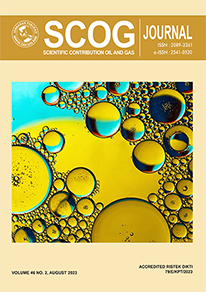The 3D Seismic Survey Design of South Walio Offshore, Indonesia: Optimizing the 3D Survey Design Parameters
DOI:
https://doi.org/10.29017/SCOG.46.2.1552Keywords:
3D Survey Design, Salawati Basin, Salawati Working Area, Kais Formation & Waripi Formation, Parameter Recording & Templates.Abstract
The background of this research is to support the plan to carry out 3D seismic acquisition in the Salawati Kepala Burung Working Area located in Sorong Regency. The 3D seismic design study was applied to better understand the physical properties of the Mesozoic clastic reservoir in the Salawati basin and its surroundings, especially in the offshore area. The study aims to evaluate the parameters of a reliable 3D seismic acquisition design to meet efficiency in financing in realizing the 3D seismic data acquisition program. Determine the recording parameters to image the Kais Formation and Waripi Formation targets by building a geophysical analysis model using existing 2D data and well-log information. Based on this model, using the Kais and Waripi formation properties to calculate and analyze vertical and horizontal resolution, bin size, aperture migration, and maximum offset. Synthetic acquisition 2D modeling is applied in this study to perform vertical and horizontal resolution analysis and obtain optimum and reliable bin size parameters and aperture migration. With this knowledge, we calculate the theoretical parameters of the survey. After determining the most critical theoretical parameters of the study, the next step is to determine the distance between the source and receiver. Then define the recording template. It is done by considering the bin size for the 3D model, offset boundaries, and suitable folds for inner targets. In the second, an analysis of the other two most important attributes is carried out, namely the offset and azimuth distribution. It is realized that every 3D survey design compromises technical factors affecting 3D survey costs starting from the technical requirements of field activities. The results of this study are recommendations and suggestions for two main alternative models of recording parameters and templates in the form of ideal source-receiver layout models, namely orthogonal and diagonal, and the minimum prerequisites that are expected to be able to map and determine the characteristics of the shallow and deep play type models in the South Walio offshore areas.
References
Babu, N.M., Baskey, B., Thota, V.G., 2022, Evaluation of 3D seismic survey design parameters through ray-trace modeling and seismic illumination studies: a case study. J Petrol Explor Prod Technol 12, 3021–3031 (2022)
Cordsen, A., Galbraith, M., Peirce, J., 2000, Planning land 3-D seismic surveys, Soc. Expl. Geophys., Tulsa, Oklahoma
Dümmong, S., Baykulov, M., Dirk Gajewski, D., 2009, "A workflow for the processing of reflection seismic data with CRS attributes," SEG Technical Program Expanded Abstracts : 3173-3177
Doust, H. & Noble, R., 2008, Petroleum systems of Indonesia. Marine and Petroleum Geology - MAR PETROL GEOL. 25. 103-129. 10.1016/j.marpetgeo.2007.05.007
Downloads
Published
Issue
Section
License
Copyright (c) 2023 © Copyright by Authors. Published by LEMIGAS

This work is licensed under a Creative Commons Attribution 4.0 International License.
Authors are free to Share — copy and redistribute the material in any medium or format for any purpose, even commercially Adapt — remix, transform, and build upon the material for any purpose, even commercially.
The licensor cannot revoke these freedoms as long as you follow the license terms, under the following terms Attribution — You must give appropriate credit , provide a link to the license, and indicate if changes were made . You may do so in any reasonable manner, but not in any way that suggests the licensor endorses you or your use.
No additional restrictions — You may not apply legal terms or technological measures that legally restrict others from doing anything the license permits.














